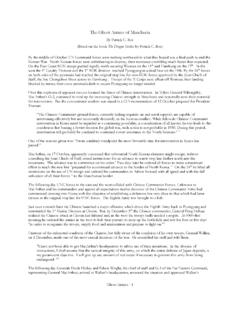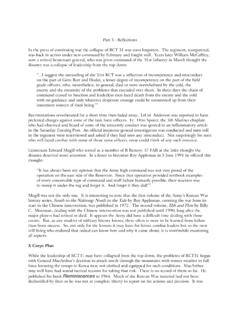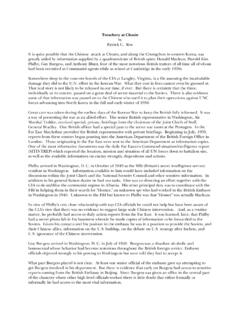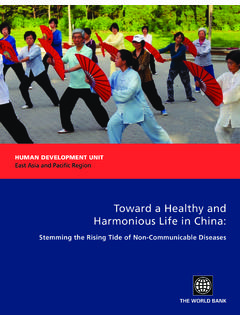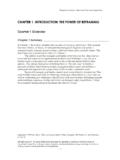Transcription of Destruction of the 31st Infantry
1 Destruction of the 31st InfantryA Tragedy of the Chosin CampaignbyPatrick C. RoeMajor, USMC (Ret)228 Salmon Point RoadLopez Island, WA I - IntroductionThe crucial battles of the Chosin Campaign, which had a decisive impact on the future course of thewar, were fought in the ten day period between November 27 and December 6 , 1950. Four differentactions were fought; the successful defense of Hagaru; the successful defense of Yudam-ni; thesuccessful effort of the 5th and 7th Marines to break through from Yudam-ni to Hagaru-ri; the fight ofRCT 31, East of Chosin. In the first three of these battles elements of the 1st Marine Division weresuccessful in holding their position, and then withdrawing intact so that at the conclusion of theaction they remained effective fighting forces.
2 At the conclusion of each of these three actions theopposing Chinese forces were badly damaged. In the battle East of Chosin the army forces there wereessentially destroyed as an effective fighting force. But, in the course of their Destruction they held incheck and inflicted significant damage to a sizeable Chinese forces which might otherwise haveovercome the defenders of Hagaru-ri. Loss of thatkey location would have made the withdrawal ofthe Marines vastly more December 6th, when the 1 Marine Divisionstcommenced its attack south from Hagaru-ri, all ofthe hard fighting was not over but precious timehad been gained for scattered X Corps forces toconcentrate and secure Hamhung. The 3rdInfantry Division had assembled at Hamhung onthe 4th . The following day the bulk of the 7thInfantry Division arrived.
3 During that period, theattacking Chinese forces had been severely mauledby the fighting with the 1st Marine Division, bythe attacks of supporting air, and by theunexpectedly severe weather. As a result when the 1st Marine Divisioncompleted it successful withdrawal to Hamhung XCorps was able to withdraw from North Korea,intact, able to reinforce the Eighth Army and haltthe Chinese offensive. The plans then inpreparation for withdrawal of all U. S. forces fromKorea were not necessary. The war couldcontinue. The significant contribution of RCT31 to this overall success was made at a terrible cost, the result ofan escalating succession of logistical, tactical, command and communication failures. It was one thegreat, and unnecessary, tragedies of the Korean War.
4 Nevertheless, RCT 31, surrounded and sufferingheavy casualties, for five crucial days kept two CCF divisions engaged, contributing to the successfulwithdrawal of the Marines and, ultimately, to the successful withdrawal of X Corps from of the almost complete Destruction of RCT31 there are few contemporaneous records. Nearlyall information on the events there come from after-the-fact official reports and personal recollectionsof those who survived. Some of those personal recollections and statements were written many yearslater when memories have faded, although it must be said that recollection of those events wasindelibly engraved on the memories of those who were there. Any attempt to recreate a coherentpicture of events has to deal with these obstacles, and with strongly opposing viewpoints.
5 In theabsence of direct evidence of some events historical candor requires inference from the circumstances. In this and in other studies I have done that for whatever criticism may be warranted. X Corps Moves North If strategy sets the conditions under which battles are fought then the deliberations and actionsleading to the decision to reorient X Corps attack to the west to assist Eighth Army set the stage forthe Chosin battles. On 24 Oct just as X Corps was preparing to land at Wonsan, General MacArthur ordered all UNCforces in Korea to drive forward with all speed, and with the full utilization of all their force, to secureall of North Korea. The following day UNC forces made initial contact with the Chinese both in thethe Eighth Army sector in the west and in the northeast on the road to Chosin.
6 By the 6th ofNovember, the Chinese, in western Korea, had driven the Eighth Army back to the Chongchon River. In northeast Korea the 7th Infantry Division had begun landing at Iwon and moving north meetingonly occasional resistance from retreating North Korean units. On the road to Chosin the 1st MarineDivision had passed through ROK units and, after a fierce fight with the Chinese, had advanced to thefoot of the Funchillin Pass where the 7th Marines faced determined Chinese resistance occupying wellconstructed field fortifications. General Edwin , Far Eastern Command G-3, worried. X Corps was scattered in small unitsspread over 160 miles from south to north and nearly the same distance west to east. Deployed as itwas the corps was in no position to lend support to the Eighth Army.
7 It was not even able to providemutual support to its own units. General Wright's concern was echoed in Washington. The NationalSecurity Council had met November 9th to discuss China's apparent entry into the war. At thatmeeting Defense Secretary Marshall noted the dispersion of X Corps and questioned it. GeneralBradley believed this disposition had been made by MacArthur in order to carry out his directive tooccupy the entire country and hold elections . Bradley's statement was a clue there might be some1misunderstanding, both by MacArthur and Bradley, of just what MacArthur's instructions were. Despite the unexpected appearance of Chinese forces General Eward M. Ned Almond, X Corpscommander, was intent on pushing ahead to occupy all of North Korea in his zone.
8 Then, on the 7th2of November, Chinese forces, on both sides of Korea, suddenly and mysteriously withdrew. In thewest Eighth Army units moved forward to positions ready to renew their offensive as soon as suppliescould be built up. In the northeast the 7th Marines of the 1st Marine Division secured the FunchillinPass and reached Koto-ri by November 10th . This opened a huge gap between the Marines, on theleft flank of X Corps, and the nearest Eighth Army units. So, on 10 November General Almond wasalerted to a possible change of mission. In a personal letter to the X Corps Commander GeneralWright relayed General MacArthur s instructions for Almond to become familiar with Eighth Armyplans in order to be prepared for any possible change in the situation. He suggested that X Corpsplans be developed for a strong effort in coordination with resumption of the Eighth Army offensive,which, at that time, was anticipated to commence on November 15th.
9 3 Planning for the Attack West Reassured by the Chinese withdrawal General Almond issued his Operation Order No. 6 onNovember 11 to resume the advance. The order stated the X Corps mission: "Destroy enemy in zonethand advance to the Northern Border of Korea." The 1st Marine Division , 7th Infantry Division and IROK Corps were all ordered to advance and "destroy enemy in zone." The border in the 1st MarineDivision's zone was more than 85 airline miles away (perhaps double that by road) through some ofthe most difficult and mountainous terrain in Korea. No intermediate objectives were given eitherdivision. In the ordinary military usage this meant that each unit was to advance without regard tothe progress of units on either flank. It was an order for all out exploitation.
10 As an apparentconcession to the General MacArthur s letter to be prepared to assist the Eighth Army, both the 3rdInfantry Division, just arriving, and the 1st Marine Division, were directed to be prepared for offensiveoperations to the west on Almond was not pleased with the prospect of th turning west. On the 14th he replied toWright s letter outlining his objections to the plan to turn west. X Corps, Almond said, was capableof turning west if needed. But it appeared that the Chinese offensive had been contained by theEighth Army. X Corps could best support Eighth Army by continuing north which would also directlycontribute to the overall objective of securing all of North as expeditiously as possible. Once farther north X Corps could then assist Eighth Army by threatening Chinese supply lines.
